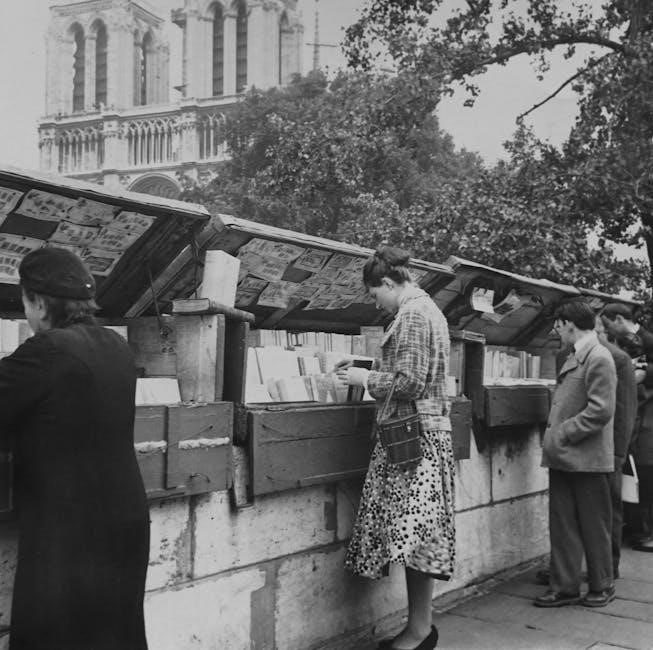These worksheets provide engaging reading passages and activities to teach students about influential women and their contributions to history. Designed for all ages, they include comprehension quizzes, essay questions, and inspiring stories about pioneers like Sally Ride, Sojourner Truth, and modern leaders. Perfect for March celebrations, these resources make learning fun and meaningful, fostering a deeper understanding of women’s achievements and their impact on society.
Why Reading Comprehension is Essential for Understanding Women’s History
Reading comprehension is vital for understanding women’s history, as it allows students to engage deeply with the stories and achievements of influential women. By analyzing passages about historical figures like Sojourner Truth, Rosa Parks, and modern leaders, students develop critical thinking skills and empathy. These worksheets encourage learners to connect emotionally and intellectually with women’s contributions, fostering a broader understanding of their roles in shaping society. This skill not only enhances academic performance but also prepares students to discuss and appreciate women’s history effectively, both in and out of the classroom.
The Importance of Celebrating Women’s History Month in Education
Celebrating Women’s History Month in education fosters inclusivity and diversity, highlighting women’s contributions to society. Worksheets featuring inspiring stories of pioneers like Malala Yousafzai and Helen Keller empower students to appreciate women’s achievements. These resources encourage empathy and critical thinking, making history engaging and relatable. By integrating these materials into the curriculum, educators promote equality and inspire future generations to value women’s roles in shaping the world. This celebration not only honors the past but also motivates students to strive for a more inclusive future.
A Brief History of Women’s History Month
Originating from a 1978 California week-long celebration, Women’s History Month gained national recognition in 1980 and became a month in 1987, honoring women’s contributions and achievements.
Origins and Evolution of Women’s History Month
The celebration of Women’s History Month traces its roots to a 1978 week-long event in Sonoma County, California, organized by the Sonoma County Commission on the Status of Women. Inspired by the women’s rights movement, this local initiative gained momentum, leading President Jimmy Carter to declare a national week in March 1980. By 1987, Congress expanded the celebration to the entire month of March. This evolution reflects the growing recognition of women’s contributions to history, culture, and society. Today, it serves as a platform to educate and inspire future generations through resources like reading comprehension worksheets, highlighting key milestones and influential figures.
Key Milestones in Women’s History That Every Student Should Know
Key milestones in women’s history include the Women’s Suffrage Movement of the 1850s, which fought for voting rights, and the passage of the 19th Amendment in 1920, granting women the right to vote. The Civil Rights Movement and the 1960s-70s Women’s Rights Movement further advanced equality. Modern milestones like Kamala Harris becoming the first female Vice President in 2020 highlight ongoing progress. These events are essential for understanding women’s contributions and struggles, making them central to educational materials like reading comprehension worksheets that celebrate Women’s History Month.

Benefits of Using Reading Comprehension Worksheets
Reading comprehension worksheets enhance engagement and inspire students to learn about influential women and historical events, fostering a deeper understanding and appreciation of their impact.
How Worksheets Enhance Learning and Engagement
Worksheets designed for Women’s History Month captivate students with engaging reading passages about trailblazing women, fostering curiosity and motivation. By including comprehension quizzes and essay questions, these resources encourage active participation and deeper understanding. Interactive elements like word searches and multimedia integration make learning dynamic, while age-specific content ensures relevance for diverse learners. Such tools not only enhance academic skills but also inspire students to explore the stories of influential women, making history relatable and meaningful. This approach creates a supportive environment for students to connect with the achievements of women who shaped the world.
Developing Critical Thinking Skills Through Reading Comprehension
Reading comprehension worksheets for Women’s History Month empower students to analyze and interpret texts about influential women, fostering critical thinking. By evaluating passages on achievements, challenges, and societal impacts, students learn to extract key details and form well-supported opinions. Essay questions and discussions encourage deeper reflection, helping students connect historical events to modern issues. These activities promote analytical skills, enabling learners to think independently and empathetically about women’s roles in shaping history. Such exercises not only enhance comprehension but also cultivate a mindset of inquiry and appreciation for diverse perspectives.

How to Choose the Right Worksheets for Your Students
Selecting the right worksheets involves considering age, grade level, and educational goals. Ensure materials align with curriculum standards and provide engaging, relevant content for diverse learners.
Factors to Consider When Selecting Reading Comprehension Materials
When selecting reading comprehension materials for Women’s History Month, consider the age and grade level of your students to ensure the content is appropriate and engaging. The materials should align with curriculum standards and educational goals, fostering both knowledge and critical thinking. Additionally, choose worksheets that highlight diverse perspectives, including women from various cultures and backgrounds, to promote inclusivity. Consider the inclusion of multimedia and interactive elements to enhance engagement. Finally, ensure the materials are accessible and adaptable to meet the needs of all learners, including English Language Arts students and those with different learning styles.
Age-Appropriate and Grade-Specific Worksheets
Ensure reading comprehension materials are tailored to students’ age and grade levels for optimal engagement. Worksheets for younger students may include simple passages and word searches, while older students benefit from detailed texts and essay questions. For instance, 3rd and 4th graders can use free PDF samples featuring inspiring stories of women like Malala Yousafzai and Rosa Parks. These resources are designed to be accessible and challenging, fostering a love of learning while aligning with educational standards. Age-specific materials help teachers address diverse learning needs, ensuring every student can participate meaningfully in celebrating Women’s History Month.

Designing Effective Reading Comprehension Worksheets
Effective worksheets blend engaging content with structured activities. Include inspiring narratives of influential women, interactive elements, and clear instructions to captivate students and enhance learning outcomes.
Best Practices for Creating Engaging and Educational Materials
When designing reading comprehension worksheets, prioritize clarity and age-appropriateness. Use inspiring stories of women like Sally Ride and Sojourner Truth to spark interest. Ensure passages are concise, with questions that promote critical thinking. Incorporate multimedia and interactive elements to enhance engagement. Align content with educational standards, making it relevant and challenging. Provide clear instructions and include discussion prompts to foster deeper understanding. Use real-life examples to connect historical achievements with modern-day relevance, inspiring students to appreciate women’s contributions. Make materials accessible and free, ensuring all students can benefit, while maintaining high-quality content.
Incorporating Multimedia and Interactive Elements
Enhance reading comprehension worksheets with multimedia and interactive elements to boost engagement. Include videos, images, or audio clips that highlight women’s achievements, such as speeches by influential leaders or historical footage. Add clickable timelines, quizzes, or drag-and-drop activities to make learning immersive. Use interactive PDFs with hyperlinks to additional resources, like biographies of pioneers such as Malala Yousafzai or Rosa Parks. These features cater to diverse learning styles, making the content more accessible and dynamic. Ensure compatibility with digital devices to support online learning environments, fostering a more interactive and inclusive educational experience for all students.
Technology and Digital Tools for Reading Comprehension
Digital tools like interactive PDFs and online platforms enhance reading comprehension by offering engaging, multimedia-rich experiences. These resources integrate seamlessly with learning management systems, making women’s history education accessible and dynamic for modern learners.
Using PDF Worksheets in the Digital Classroom
PDF worksheets are a versatile tool for integrating women’s history into digital classrooms. They can be easily shared via learning platforms, ensuring accessibility for all students. Interactive features like fillable fields and embedded links enhance engagement. Teachers can track progress by exporting completed worksheets, while students benefit from clear, structured activities. PDFs also support offline learning, making them ideal for diverse classroom settings. Their compatibility with various devices ensures that reading comprehension exercises remain consistent and effective, whether used in class or as homework.
Interactive Reading Comprehension Activities for Online Learning
Interactive reading comprehension activities, such as drag-and-drop exercises and online quizzes, make learning about women’s history engaging and dynamic. Multimedia elements like videos and audio clips enhance understanding. These activities align with educational standards and cater to diverse learning styles. By incorporating real-time feedback, teachers can monitor student progress effectively. Interactive tools also foster collaboration, allowing students to discuss and share insights virtually. These resources ensure that learning about women’s history is both informative and enjoyable, preparing students to appreciate the contributions of influential women in shaping society.
Influential Women Featured in Reading Comprehension Worksheets
These worksheets highlight the stories of trailblazing women like Rosa Parks, Harriet Tubman, and Kamala Harris, inspiring students to learn about their impactful roles in shaping history.
Pioneers in Women’s Rights and Their Stories
Worksheets feature inspiring stories of pioneers like Sojourner Truth, Susan B. Anthony, and Elizabeth Cady Stanton, who fought tirelessly for women’s rights. Their courageous efforts, from abolition to suffrage, are highlighted through engaging reading passages and comprehension activities. These materials educate students about the struggles and triumphs of these trailblazers, emphasizing their enduring impact on equality and justice. By exploring their stories, students gain a deeper understanding of the women’s rights movement and its significance in shaping modern society. These resources make history relatable and inspiring for young learners. The worksheets also include quizzes to reinforce learning and critical thinking skills.
Modern Women Leaders and Their Contributions to Society
Reading comprehension worksheets highlight modern women leaders like Kamala Harris, Malala Yousafzai, and Ruth Bader Ginsburg, showcasing their transformative contributions. These materials explore their roles in politics, education, and law, inspiring students to learn about contemporary achievements. Worksheets include passages on leaders who have broken barriers, fought for equality, and innovated in their fields. By engaging with these stories, students develop critical thinking skills and gain insights into the ongoing impact of women in shaping today’s world. These resources also include comprehension exercises to reinforce learning and encourage reflection on modern leadership.
Aligning Worksheets with Educational Standards
These worksheets are designed to meet curriculum requirements, ensuring they align with educational standards and integrate seamlessly into core subjects, providing a comprehensive learning experience for students.
Meeting Curriculum Requirements Through Reading Comprehension
Reading comprehension worksheets for Women’s History Month are crafted to align with educational standards, ensuring they meet curriculum goals. These resources integrate seamlessly into English Language Arts and Social Studies, providing students with engaging passages about influential women. The materials cover key historical events, such as the Women’s Suffrage Movement, and highlight modern achievements. By focusing on critical thinking and analysis, these worksheets help students develop essential skills while fostering an appreciation for women’s contributions to society. This approach ensures a well-rounded educational experience that honors diverse perspectives and achievements.
Integrating Women’s History into Core Subjects
Women’s History Month reading comprehension worksheets seamlessly integrate into core subjects like Science, Math, and Arts. For instance, biographies of women in STEM fields, such as Sally Ride or Patricia Bath, enhance Science lessons. Historical events, like the Suffrage Movement, align with Social Studies curricula, fostering a deeper understanding of societal progress. These resources connect real-world achievements to academic topics, ensuring students see the relevance of women’s contributions across disciplines. By embedding these stories into core subjects, educators create a holistic learning experience that honors diversity and inspires future generations to pursue various fields. This approach enriches the curriculum and student engagement.

Engaging Students with Diverse Perspectives
Women’s History Month worksheets highlight stories of women from diverse cultures and backgrounds, such as Rosa Parks and Malala Yousafzai, inspiring students to appreciate global contributions and perspectives.
Highlighting Women from Different Cultures and Backgrounds
Reading comprehension worksheets celebrate women from diverse cultures, such as Malala Yousafzai, Frida Kahlo, and Harriet Tubman, showcasing their unique contributions to history. These stories inspire students to appreciate global perspectives and the universal fight for equality. By including women like Rosa Parks and Sojourner Truth, the worksheets emphasize the importance of cultural diversity in shaping history. These engaging passages and activities help students connect with the experiences of women from varied backgrounds, fostering empathy and a broader understanding of the world.
Addressing Diversity and Inclusion in Educational Materials
Women’s History Month worksheets promote diversity by featuring stories of women from various ethnicities, professions, and historical periods. These materials ensure inclusive representation, highlighting achievements of women like Kamala Harris, Patricia Bath, and Amelia Earhart. By incorporating diverse perspectives, the worksheets help students recognize the universal impact of women’s contributions. They also address the importance of equality and provide a platform for discussing underrepresented voices, ensuring all students can relate and learn from these inspiring stories.

Assessment and Feedback Strategies
Worksheets include quizzes and activities to assess understanding of women’s history. They help track progress, identify gaps, and provide immediate feedback, enhancing learning outcomes effectively.
Tracking Progress with Reading Comprehension Worksheets
Utilizing reading comprehension worksheets allows educators to monitor students’ progress effectively. Each worksheet includes quizzes and activities that assess understanding of women’s history topics. By reviewing answers, teachers can identify knowledge gaps and adapt instruction. These tools also enable students to reflect on their learning, fostering self-improvement. The structured format of these worksheets ensures consistent assessment, making it easier to track development over time and celebrate growth in comprehension and critical thinking skills.
Using Worksheets as a Tool for Formative Assessment
Worksheets serve as valuable tools for formative assessment, helping educators gauge students’ understanding of women’s history topics. By incorporating quizzes, short answers, and essay questions, these resources provide immediate insights into students’ knowledge. Teachers can identify areas where learners need additional support and adjust instruction accordingly. The structured format of these worksheets ensures consistency in assessment, while their printable nature allows for flexible use in classrooms. This approach not only enhances learning but also encourages personalized instruction, making formative assessment an integral part of the educational process during Women’s History Month.

Free and Accessible Resources for Teachers
Discover free and accessible PDF worksheets for teaching women’s history. Websites like EasyTeacherWorksheets.com and ReadWorks.org offer printable reading comprehension materials, making lesson planning effortless for educators.
Where to Find High-Quality, Free Reading Comprehension Worksheets
Educators can access high-quality, free reading comprehension worksheets for Women’s History Month through reputable websites like EasyTeacherWorksheets.com and ReadWorks.org. These platforms offer PDF downloadable materials featuring inspiring stories of influential women such as Malala Yousafzai, Rosa Parks, and Amelia Earhart. Many resources include reading passages, comprehension questions, and essay prompts, making them ideal for diverse grade levels. Additionally, some websites provide free samples or open educational resources (OER) that align with curriculum standards, ensuring accessibility and quality for teachers worldwide.
Utilizing Open Educational Resources (OER)
Open Educational Resources (OER) offer a wealth of free, high-quality materials for teaching Women’s History Month. These resources, often shared by educators and organizations, include reading passages, comprehension questions, and interactive activities. OER platforms provide PDF worksheets and digital tools that can be easily downloaded and adapted to meet classroom needs. Many resources are designed to align with educational standards, ensuring they are both relevant and effective. By leveraging OER, teachers can access diverse perspectives and inspiring stories of women’s achievements, fostering engaging and inclusive learning experiences for students of all ages.
Success Stories and Case Studies
Schools have reported improved student engagement and understanding after implementing Women’s History Month reading comprehension worksheets. These resources have proven effective in inspiring learners and fostering curiosity about women’s contributions to history, with many educators praising their adaptability and educational value.
How Schools Have Successfully Implemented Women’s History Month Worksheets
Schools have effectively integrated Women’s History Month reading comprehension worksheets into their curricula, enhancing student engagement and understanding. Many educators incorporated these resources into daily lessons, using the passages as a starting point for group discussions and reflective writing activities. Interactive elements, such as quizzes and essay prompts, were particularly popular, encouraging students to think critically about the roles of influential women. The worksheets also served as a springboard for broader explorations of women’s contributions to science, politics, and the arts. This approach not only improved reading skills but also fostered a deeper appreciation for diverse perspectives and historical achievements.
Testimonials from Educators and Students
Educators have praised Women’s History Month reading comprehension worksheets for their engaging and educational value. One teacher shared, “These worksheets brought history to life for my students, sparking meaningful discussions about women’s contributions.” Students also expressed enthusiasm, with one noting, “Reading about Malala Yousafzai and Rosa Parks inspired me to learn more about women who changed the world.” The interactive format and inspiring stories have made these resources a favorite in classrooms, fostering both learning and appreciation for women’s history. The positive feedback highlights their effectiveness in creating a lasting impact on young minds.
Women’s History Month reading comprehension worksheets are a valuable tool for fostering learning and appreciation of women’s history. By engaging students with inspiring stories and critical thinking exercises, these resources promote a deeper understanding of women’s contributions to society. They not only enhance educational outcomes but also encourage a lifelong interest in history, empowering future generations to celebrate and learn from the achievements of remarkable women.
Summarizing the Importance of Women’s History Month Reading Comprehension
Women’s History Month reading comprehension worksheets are essential for fostering engagement and understanding of women’s history. These resources provide students with inspiring stories of influential women, from pioneers like Sojourner Truth to modern leaders like Kamala Harris. By incorporating reading passages, quizzes, and essay questions, the worksheets promote critical thinking and a deeper appreciation of women’s contributions. They also highlight diverse achievements in science, politics, and culture, making them a valuable tool for inclusive education. Ultimately, these materials empower students to connect with history and inspire future generations to celebrate women’s impact on society.
Encouraging Lifelong Learning About Women’s History
Women’s History Month reading comprehension worksheets inspire students to embrace women’s history as a year-round learning journey. By exploring stories of trailblazers like Malala Yousafzai and Rosa Parks, these resources spark curiosity and empathy. They empower students to recognize the profound impact of women across cultures and time, fostering a deeper connection to history. With engaging passages and activities, the worksheets make learning accessible and fun, encouraging students to explore beyond the classroom. This approach not only celebrates achievements but also nurtures a lifelong appreciation for the diverse contributions of women, enriching education and inspiring future generations to value equality and inclusion.
